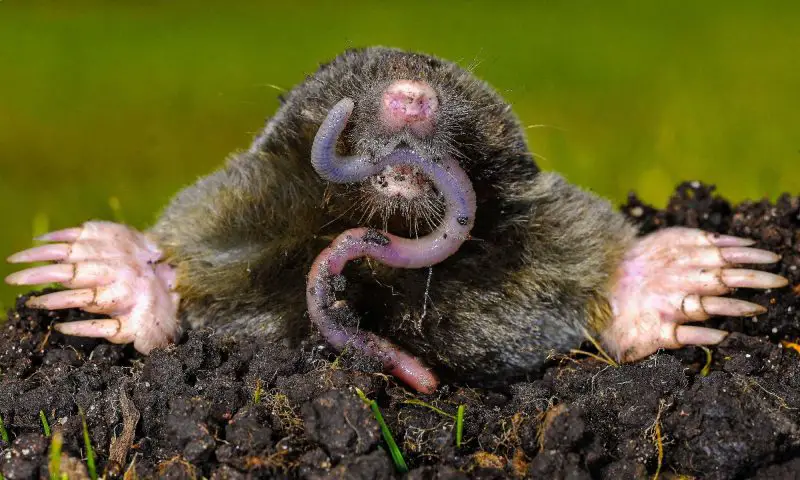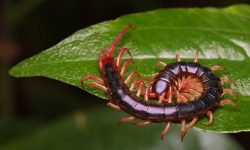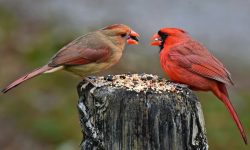Moles spend almost their entire lives underground, hidden away in networks of tunnels where they forage, hunt and rest. Because they live in complete darkness, their diet is built around the insects and soft-bodied creatures that share the soil with them. Understanding what moles eat gives us valuable insight into why they dig so persistently and how they help shape the ecosystems found beneath our feet.
Rather than using their eyes, moles rely on powerful senses of touch, vibration detection and smell to locate food. Their cylindrical bodies, shovel-like forelimbs and strong claws make them exceptional diggers capable of creating long tunnel systems in surprisingly short periods of time. Their high metabolism requires constant feeding, which explains why they spend so much time searching for nutrient-rich prey hidden in the soil.
This guide explores 20 foods moles search for beneath the soil, helping explain their natural behavior, ecological role and impressive underground hunting strategy. Whether you’re observing wildlife or managing a lawn, knowing what moles eat brings clarity to their secretive lifestyle.
Understanding the Mole Diet

Moles are insectivores, meaning their diet revolves around insects, larvae and other small invertebrates they find underground. Their bodies demand high amounts of protein and moisture, and the soil environment provides exactly that. A mole’s daily food intake can equal almost its entire body weight, which shows just how much energy tunneling requires.
Most of their prey consists of creatures that live in damp, loose soil. Earthworms are especially important to moles because they are nutritious, abundant and easy to detect through subtle vibrations. Moles also eat larvae, beetles, ants, termites and various soil-dwelling arthropods. Their saliva contains toxins that can paralyze prey, allowing moles to store live food in underground chambers.
Instead of hunting on the surface, moles create networks of tunnels that act like traps. As insects crawl through loose soil, they fall into the mole’s path, making it easier for the mole to catch them without expending unnecessary energy. Their diet is designed perfectly for their environment, and it plays a major role in controlling soil insect populations.
20 Foods Moles Search for Beneath the Soil
1. Earthworms
Earthworms are the backbone of a mole’s diet and one of the most nutrient-rich foods available underground. Their soft bodies make them easy to consume, and their moisture content keeps moles hydrated naturally. Earthworms are also abundant in healthy soil, giving moles a reliable food source year-round.
Moles detect earthworms through vibrations and movement in the soil. When worms wriggle closer to tunnels, moles quickly seize them with their sharp teeth. A single mole can consume dozens of earthworms daily to maintain its energy levels.
In wetter seasons, earthworms move closer to the surface, and moles create more shallow tunnels to take advantage of this easy access.
2. Beetle Larvae
Beetle larvae live in soil and decaying plant matter, making them perfect prey for moles. Their soft bodies and high-fat content provide a rich source of energy. They are especially important during cooler months when other insects become less active.
Moles locate beetle larvae by sensing slight movements in the soil. They dig toward the source and quickly devour the larvae before they can escape. These larvae often gather near roots, giving moles predictable hunting spots.
Because larvae are plentiful in many types of soil, they form a dependable part of the mole’s natural diet.
3. Ants
Ants are common in many underground environments, and moles take advantage of their presence. Although small, ants are abundant enough to serve as frequent snacks. Moles often raid ant tunnels when passing through active colonies.
They may consume both adult ants and developing brood. Ant tunnels sometimes intersect mole tunnels naturally, allowing the mole easy access to these tiny insects.
The protein and moisture in ants help support the mole’s high metabolic rate, especially during heavy digging periods.
4. Termites
Termites are soft-bodied insects that make excellent prey. Moles target termite workers and soldiers when they encounter colonies beneath the soil. Their high protein content makes termites valuable for energy and body maintenance.
Termite colonies typically live near moist wood or decaying roots, which are also areas moles frequently travel. When moles break into a termite gallery, they often eat dozens of insects in a short period.
Termites also help hydrate moles due to their moisture-rich bodies.
5. Grubs
Grubs, or immature beetles, are nutrient-packed larvae found in lawns and gardens. They are high in fat and protein, making them ideal for moles that need dense nutrition. Moles commonly hunt grubs near grass roots.
People often notice mole tunnels in areas with heavy grub populations because moles follow these larvae underground. The grubs’ slow movement makes them easy targets.
Grubs contribute major calories to a mole’s daily intake, especially in late spring and early summer.
6. Millipedes
Millipedes are slow-moving soil dwellers, making them convenient prey. Though they contain defensive chemicals, moles generally tolerate them well and consume smaller species readily.
Millipedes thrive in damp soil and leaf litter, areas that moles explore regularly. Their long bodies provide a surprising amount of nutrition.
Moles may target millipedes more often during rainy seasons when these arthropods become more active.
7. Centipedes
Centipedes are fast and have strong jaws, but moles still catch them with precise timing. Their protein-rich bodies make them worthwhile prey, particularly the small- to medium-sized species.
Moles use their sensitive snouts to detect centipede movement underground. Once cornered, centipedes are quickly subdued with a bite that neutralizes their defensive abilities.
Centipedes help supply essential nutrients that support muscle function and high metabolic demands.
8. Spiders
Many spider species live underground or hide near soil cracks. Moles come across them often during tunneling. Spiders offer lean protein and are small enough for moles to eat quickly.
Moles don’t specifically seek spiders out but consume them opportunistically. When spiders fall into tunnels or hide near roots, moles easily catch them.
These small prey items help supplement meals between larger insects.
9. Sowbugs (Pill Bugs)
Sowbugs thrive in moist soil and decomposing plant matter, making them abundant around mole tunnels. Their cool, damp habitats overlap perfectly with mole hunting routes.
Although sowbugs are not as nutrient-dense as worms or grubs, they add variety to the mole’s diet. Their small size makes them easy to grab and swallow.
Their availability year-round makes them a reliable supplementary food source.
10. Earwigs
Earwigs are common in loose soil and mulch, allowing moles to encounter them frequently. Their slender bodies are easy to eat, and they provide moderate protein.
Moles often find earwigs hiding under roots or near rotting vegetation. These insects gather in groups, giving moles multiple prey items at once.
Their predictable hiding spots help moles conserve energy while foraging.
11. Crane Fly Larvae
Crane fly larvae, also known as leatherjackets, are abundant in wet soil. These soft-bodied larvae are rich in moisture and nutrients, making them a valuable food source.
Moles detect these larvae near grass roots where they feed on organic matter. Their slow, worm-like movement makes them easy to catch.
Crane fly larvae are especially important in regions with cool, moist climates.
12. Springtails
Springtails are tiny, jumping soil arthropods moles eat in large quantities. Their small size means each individual provides only a small amount of nutrition, but their abundance makes up for it.
Springtails thrive in healthy, moist soil—exactly the conditions moles prefer. As moles tunnel, they often swallow clusters of springtails without even hunting intentionally.
They help sustain energy levels during active digging sessions.
13. Small Beetles
Small beetles live throughout the soil and offer moderate protein. Moles catch them easily when beetles fall into tunnels or crawl near roots.
Beetles are sturdier than larvae, but moles’ sharp teeth allow them to crush the hard exoskeleton. They are more common in drier soils where worms and grubs are less abundant.
As opportunistic feeders, moles eat beetles whenever they come across them.
14. Slugs
Slugs are soft and moisture-rich, making them appealing prey for moles. They are easy to catch, especially in damp soil and gardens.
Moles locate slugs by detecting their movement or moisture trails. Slugs provide hydration along with protein.
In rainy seasons, moles may consume slugs more frequently because of their increased activity.
15. Snails (Small Ones)
Small snails serve as occasional prey. Although their shells add little nutritional value, the soft inner body provides protein and moisture.
Moles crush snail shells easily and access the soft tissue inside. Snails often hide near roots or moist soil, areas moles frequent.
Their availability varies by season, making them more common food during wet periods.
16. Wireworms
Wireworms are the larvae of click beetles and live deep in soil. Their elongated bodies contain dense nutrients that support mole energy needs.
Moles locate wireworms by sensing subtle vibrations as the larvae move through soil. These larvae often gather in garden beds or crop fields.
Wireworms supply slow-burning nutrition that helps moles stay active during long tunneling periods.
17. Termite Larvae
Termite larvae are particularly soft and nutritious. When moles break into a termite nest, they often consume large numbers of larvae at once.
These larvae provide essential protein and hydration. Termite colonies are strong food sources in regions with decaying wood underground.
Termite larvae enrich the mole’s diet during warm seasons when colonies expand.
18. Nematodes
Nematodes are microscopic worms abundant in nearly all soils. Though individually tiny, moles consume them naturally when ingesting soil during feeding.
These organisms help supplement nutrition, especially during periods when larger insects are scarce. Moles don’t target nematodes intentionally but consume them incidentally.
Their constant presence ensures moles get trace nutrients year-round.
19. Root-Dwelling Insects
Many insects live near plant roots, making them easy prey for moles. These include thrips, small fly larvae and root-feeding beetles.
Moles follow root systems as natural pathways, encountering these insects as they dig. Root zones often hold moisture, making them prime hunting territory.
These insects add variety to the mole’s diet and help keep underground ecosystems balanced.
20. Soil Microarthropods
Soil microarthropods include mites, tiny insects and other small invertebrates moles consume unintentionally during feeding. They live in practically every type of soil.
Though small, their sheer numbers make them a steady background food source. As moles move through loose earth, they swallow soil containing these micro-creatures.
These organisms help supplement nutritional needs, particularly during lean seasons.
FAQs About What Do Moles Eat
What do moles eat most often?
Earthworms, beetle larvae and grubs make up most of their diet.
Do moles eat plants?
No. Moles are insectivores and do not eat roots or plant material.
Why do moles dig so much?
They tunnel to search for prey and maintain pathways where insects fall into their reach.
Do moles drink water?
They get most of their hydration from moisture-rich prey like worms and slugs.
Are moles good for soil?
Yes. They aerate soil and help control harmful insect larvae.
Do moles eat ants?
Yes, especially when ant tunnels intersect their own tunnels.
How much do moles eat per day?
Up to nearly their body weight in insects and larvae.
Do moles store food?
Yes. Their saliva can paralyze worms, allowing them to store live prey underground.
Do moles eat surface insects?
Rarely. They prefer creatures living underground.
Are moles dangerous to pets?
No. They avoid confrontation and only eat small soil invertebrates.
Final Thoughts
Moles may be hidden beneath the ground, but what they eat shapes much of the soil ecosystem above them. Their diet, centered on worms, larvae and other soft-bodied invertebrates, fuels the nonstop digging and movement that define their underground lives. By understanding what moles eat, we gain a clearer picture of their ecological role and why their presence often signals healthy, vibrant soil. Though sometimes misunderstood, moles help maintain balance below the surface—one meal at a time.






